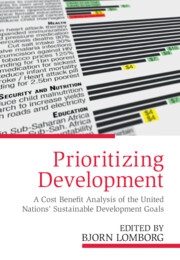 Prioritizing Development
Prioritizing Development Published online by Cambridge University Press: 30 May 2018
Summary
Both the UN Panel of Eminent Persons and the Open Working Group for Sustainable Development Goals struggled with how to frame goals for the broader water resources management challenge. It is easy to agree that water resources should be used more efficiently, but that does not necessarily mean minimizing water use. Most water problems are essentially local, and tailored local solutions must be developed. These must also recognize that water is a renewable resource; after use by humans, each molecule of water reenters the natural hydrological cycle.
All this means that it does not make economic sense to present an average benefit-cost ratio for investment in water infrastructure such as dams. Some projects make good economic sense, while others do not. One approach to providing a figure for comparison with other options under consideration in this project would be to use a baseline of some of the most economically attractive dams in the world and assume that the BCR for others would be lower. Using this approach, we find that even the large multipurpose dam in the Blue Nile gorge in Ethiopia – one of the most attractive places in the world for hydropower generation – has a much lower benefit-cost ratio than smallerscale WASH interventions.
Health policy interventions (e.g., vaccination, malaria, HIV-AIDS, hospital care) consistently dominate the Copenhagen Consensus rankings, whereas these are generally at the bottom of the list of development priorities in low-income countries. Similarly, they are not at the top of the priority list for many households in developing countries. I suggest there are five systemic reasons why the Copenhagen Consensus process overlooks the economic importance of large-scale infrastructure projects.
First, analysts underestimate the costs of targeted health and social interventions, in part because they implicitly assume that infrastructure is in place to enable the efficient delivery of health services. Ex post cost-benefit analysis of infrastructure projects often reveals cost overruns, and analysts responsible for the appraisal of large water resources projects have long been aware of this issue. More ex post cost-benefit analysis of targeted health and social policy interventions is needed to temper overly optimistic cost estimates.
To save this book to your Kindle, first ensure [email protected] is added to your Approved Personal Document E-mail List under your Personal Document Settings on the Manage Your Content and Devices page of your Amazon account. Then enter the ‘name’ part of your Kindle email address below. Find out more about saving to your Kindle.
Note you can select to save to either the @free.kindle.com or @kindle.com variations. ‘@free.kindle.com’ emails are free but can only be saved to your device when it is connected to wi-fi. ‘@kindle.com’ emails can be delivered even when you are not connected to wi-fi, but note that service fees apply.
Find out more about the Kindle Personal Document Service.
To save content items to your account, please confirm that you agree to abide by our usage policies. If this is the first time you use this feature, you will be asked to authorise Cambridge Core to connect with your account. Find out more about saving content to Dropbox.
To save content items to your account, please confirm that you agree to abide by our usage policies. If this is the first time you use this feature, you will be asked to authorise Cambridge Core to connect with your account. Find out more about saving content to Google Drive.